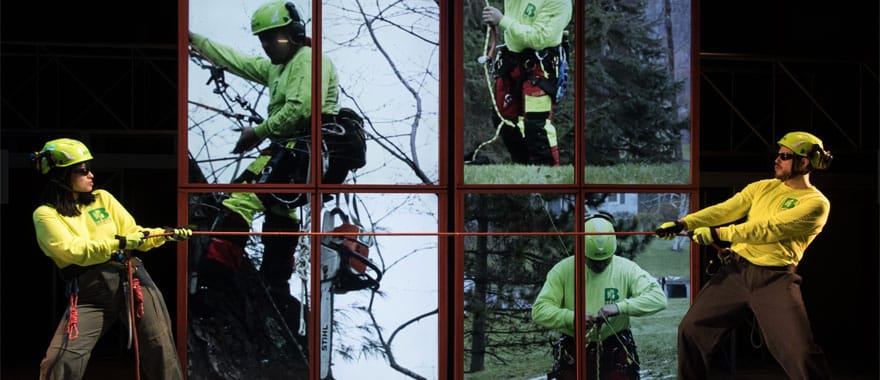
Property owners on Candlewood Lake in Connecticut are often confused by what tree work they are allowed to do because FirstLight Power Resources owns up to the 440-foot elevation line, also known as the Rocky River Project Boundary.
This confusion can lead to dangerous trees that should have been removed years ago, trees that are lacking proper maintenance, and more.
In this article, we will address some of the questions that Candlewood Lake residents and property owners frequently ask.
What is the 440 line?
The 440 line refers to the 440-foot elevation mark, where FirstLight Power Resources’ ownership begins. In most cases, property owners do not own any land on the water’s edge.
It is now referred to as the Rocky River Project Boundary.
Learn more about waterfront living and the Rocky River Project Boundary here >>
How will I know where this boundary is on my property?
Schedule a land survey to officially locate the Rocky River Project Boundary. In some cases, it deviates from the 440’ elevation line.
Your deed should also reflect that part of your property is owned by FirstLight Power Resources.
Who is FirstLight Power Resources?
FirstLight Power Resources is the owner of Candlewood Lake and the shoreline up to 440-foot elevation. They own the lake, most of the shoreline, the docks, and any trees, plants, or other vegetation within that space.
Learn more about FirstLight on their website >>
Why does FirstLight Power control the shoreline of Candlewood Lake?
Candlewood Lake was created in the 1920s to store water to create electricity and was formed behind a hydroelectric dam. It was owned by Connecticut Light and Power Company until June 2006, when it was sold to FirstLight Power Resources.
“The federal government requires FirstLight to manage shoreline property as part of its licenses issued by the federal government, which are required to operate hydropower stations.”
“Within the project boundaries, FirstLight manages shoreline uses such as the installation of docks and seawalls (among many others) to balance many interests, including power generation, environmental protection, flood control, irrigation, and public recreation.”
“As such, it is FirstLight’s responsibility to manage its lands and waters by reviewing and approving anything that might affect those operations.”
Above text was taken from FirstLight Power’s permit website page.
How Does This Impact Tree Work on My Property?
If you live on Candlewood Lake and have any property below the 440’ elevation mark, you need permission (a permit) to make any changes on that property, including removing or pruning any trees.
If you don’t receive permission, you may receive a “cease and desist” order, be required to replace anything that may have been removed, and/or need to pay a fine. Under certain circumstances, legal action may also be taken.
FirstLight recommends that you have designs, plans, and contractors (such as Barts Tree Service) in place before applying for a permit.
They also state, “Many proposals will benefit from the input of a qualified design professional, and for certain applications, FirstLight requires that you provide surveys, site plans, and other documentation prepared by a Licensed Professional.”
What other things are impacted by FirstLight owning part of my property?
You will need to receive permission for any changes made to areas owned by FirstLight, including:
- Clearing vegetation
- Building any walls or structures
- Changing or replacing a dock
How do I receive a permit to do work on the shoreline?
Shoreline and Land Use Permits can be applied for here >>
You will need to create an account and apply for your permit.
Learn more in the FirstLight Shoreline Management Handbook >>
The handbook covers permit requirements, a plant list, information on stormwater management, and more.
Questions? Contact FirstLight at la**********@*************er.com.
Do I need to mention that Barts Tree Service is working on my trees?
If you have hired us to do your tree work, then yes, you would designate Barts Tree Service as your authorized agent on your permit application.
Contact us for our contractor number, which you will need for the application.
Do I also need to request permission from my town or city to remove a tree?
In most cases, yes. Additionally, any tree removed within 200 feet of Candlewood Lake requires a jurisdictional ruling by the Inland Wetlands Commission.
Five municipalities surround Candlewood Lake
- Brookfield
- Danbury
- New Fairfield
- New Milford
- Sherman
I just moved to Candlewood Lake/purchased property on Candlewood Lake. Are there any steps I need to take?
If you purchased property that includes sections of the Rocky River Project Boundary, new owners need to apply for a land use permit from FirstLight.
How can I help protect Candlewood Lake?
Check out the Candlewood Lake Homeowner’s Guide to Lake-Friendly Living.
You can also learn more from the Candlewood Lake Authority website.
Did you know?
Candlewood Lake was named after New Milford’s Candlewood Mountain, which was named after the candlewood tree (Pinus rigida). The branches of sapling candlewood trees were previously used as candles.
Contact Barts Tree Service for your Tree Planting, Pruning, or Removal Needs
If you own property on Candlewood Lake and want to schedule tree work, contact us today to schedule your estimate. We have experience working with FirstLight and can help you through the permitting process.




 Did you know that Barts sponsors many of the events put on by the Ridgefield Playhouse? And the upcoming Green Expo and Shakespeare on the Green performance of Love’s Labour’s Lost is no exception.
Did you know that Barts sponsors many of the events put on by the Ridgefield Playhouse? And the upcoming Green Expo and Shakespeare on the Green performance of Love’s Labour’s Lost is no exception.


 Barts Tree Service is proud to sponsor this amazing comedy series at the Ridgefield Playhouse.
Barts Tree Service is proud to sponsor this amazing comedy series at the Ridgefield Playhouse.



